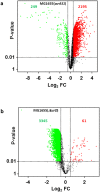The Csr system regulates genome-wide mRNA stability and transcription and thus gene expression in Escherichia coli
- PMID: 27112822
- PMCID: PMC4844966
- DOI: 10.1038/srep25057
The Csr system regulates genome-wide mRNA stability and transcription and thus gene expression in Escherichia coli
Abstract
Bacterial adaptation requires large-scale regulation of gene expression. We have performed a genome-wide analysis of the Csr system, which regulates many important cellular functions. The Csr system is involved in post-transcriptional regulation, but a role in transcriptional regulation has also been suggested. Two proteins, an RNA-binding protein CsrA and an atypical signaling protein CsrD, participate in the Csr system. Genome-wide transcript stabilities and levels were compared in wildtype E. coli (MG1655) and isogenic mutant strains deficient in CsrA or CsrD activity demonstrating for the first time that CsrA and CsrD are global negative and positive regulators of transcription, respectively. The role of CsrA in transcription regulation may be indirect due to the 4.6-fold increase in csrD mRNA concentration in the CsrA deficient strain. Transcriptional action of CsrA and CsrD on a few genes was validated by transcriptional fusions. In addition to an effect on transcription, CsrA stabilizes thousands of mRNAs. This is the first demonstration that CsrA is a global positive regulator of mRNA stability. For one hundred genes, we predict that direct control of mRNA stability by CsrA might contribute to metabolic adaptation by regulating expression of genes involved in carbon metabolism and transport independently of transcriptional regulation.
Figures






Similar articles
-
Circuitry Linking the Catabolite Repression and Csr Global Regulatory Systems of Escherichia coli.J Bacteriol. 2016 Oct 7;198(21):3000-3015. doi: 10.1128/JB.00454-16. Print 2016 Nov 1. J Bacteriol. 2016. PMID: 27551019 Free PMC article.
-
Examination of Csr regulatory circuitry using epistasis analysis with RNA-seq (Epi-seq) confirms that CsrD affects gene expression via CsrA, CsrB and CsrC.Sci Rep. 2018 Mar 29;8(1):5373. doi: 10.1038/s41598-018-23713-8. Sci Rep. 2018. PMID: 29599472 Free PMC article.
-
Antagonistic control of the turnover pathway for the global regulatory sRNA CsrB by the CsrA and CsrD proteins.Nucleic Acids Res. 2016 Sep 19;44(16):7896-910. doi: 10.1093/nar/gkw484. Epub 2016 May 27. Nucleic Acids Res. 2016. PMID: 27235416 Free PMC article.
-
Global regulation by the small RNA-binding protein CsrA and the non-coding RNA molecule CsrB.Mol Microbiol. 1998 Sep;29(6):1321-30. doi: 10.1046/j.1365-2958.1998.01021.x. Mol Microbiol. 1998. PMID: 9781871 Review.
-
Global Regulation by CsrA and Its RNA Antagonists.Microbiol Spectr. 2018 Mar;6(2):10.1128/microbiolspec.rwr-0009-2017. doi: 10.1128/microbiolspec.RWR-0009-2017. Microbiol Spectr. 2018. PMID: 29573256 Free PMC article. Review.
Cited by
-
Plasmids manipulate bacterial behaviour through translational regulatory crosstalk.PLoS Biol. 2023 Feb 14;21(2):e3001988. doi: 10.1371/journal.pbio.3001988. eCollection 2023 Feb. PLoS Biol. 2023. PMID: 36787297 Free PMC article.
-
The Post-Transcriptional Regulatory Protein CsrA Amplifies Its Targetome through Direct Interactions with Stress-Response Regulatory Hubs: The EvgA and AcnA Cases.Microorganisms. 2024 Mar 22;12(4):636. doi: 10.3390/microorganisms12040636. Microorganisms. 2024. PMID: 38674581 Free PMC article.
-
Circuitry Linking the Catabolite Repression and Csr Global Regulatory Systems of Escherichia coli.J Bacteriol. 2016 Oct 7;198(21):3000-3015. doi: 10.1128/JB.00454-16. Print 2016 Nov 1. J Bacteriol. 2016. PMID: 27551019 Free PMC article.
-
Global role of the bacterial post-transcriptional regulator CsrA revealed by integrated transcriptomics.Nat Commun. 2017 Nov 17;8(1):1596. doi: 10.1038/s41467-017-01613-1. Nat Commun. 2017. PMID: 29150605 Free PMC article.
-
Transcriptional Study of the RsmZ-sRNAs and Their Relationship to the Biosynthesis of Alginate and Alkylresorcinols in Azotobacter vinelandii.Mol Biotechnol. 2018 Sep;60(9):670-680. doi: 10.1007/s12033-018-0102-7. Mol Biotechnol. 2018. PMID: 29987520
References
Publication types
MeSH terms
Substances
LinkOut - more resources
Full Text Sources
Other Literature Sources
Molecular Biology Databases

